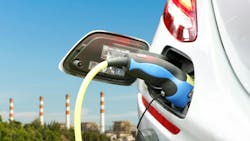UPDATED: What Did NERC Find Out About ‘Grid Friendly’ Electric Vehicle Charging?
Editor's Note: A previous version of this story was based on a draft document and not the final public report. Our thanks to NERC for pointing us to the most up-to-date version of the report.
The North American Electric Reliability Corporation, the overseer of six regional reliability entities and resource adequacy watchdog, took a look at electric vehicle adoption and issued some suggestions on how industry and regulators can come together on making sure EVs get charged without adversely affecting the bulk power grid.
In NERC’s “Potential Bulk Power System Impact of Vehicle Chargers," the corporation called for cross-sector work to address the existing knowledge gap between what utilities are expecting EV users to do and what they may actually do — the latter being something NERC’s white paper admits nobody is quite sure of and calls for more research.
According to NERC, there are big gaps in technical understanding, planning and modeling for EV charging readiness programs. Neither EV users as a group nor electric utilities and grid operators have reliable charging models, sufficient standardization of charging devices, or studies into the impact on the bulk power grid.
“NERC has determined that there are significant gaps in both the electric utility and EV charging community’s technical understanding, planning, and modeling of EV charging characteristics. While NERC has made efforts to address these knowledge gaps by working directly with EV manufacturers and other EV stakeholders, increased EV stakeholder awareness, engagement, and cross-sector collaboration is essential,” according to the white paper.
NERC finds that there is only a single, broad electrical model for EV charging, and grid operators and planners have to build better models that can make accurate predictions on EV user behavior.
"The growing penetrations of EVs necessitate a study of the real or anticipated risks that the EVs with their charging requirements bring to the electric grid," according to the white paper.
Also, EV charging systems need to be united under a common control and performance standard. If you charge two EVs from different automakers at the same charging station, the vehicles may not draw on the power grid in the same way, according to NERC.
“This lack of standardization makes grid planning difficult. Efforts are under way within the electric industry to address this issue,” according to the white paper.
Finally, NERC says, EVs and their charging systems' impact on the power grid have not been sufficiently studied.
To combat this, NERC performed a study based on the lone model available at the moment to examine this EV charger-power grid interaction. The corporation found EV chargers can adversely affect the bulk power delivery system’s reliability depending on how they draw current.
EV chargers are currently designed only for user convenience and not for overall grid stability. This needs to change, according to NERC’s directions, and could conceivably come about through collaboration between manufacturers and the utility industry.
NERC recommends EV and charging manufacturers reach out to utilities and develop standards and performance guidelines to promote what NERC calls grid-friendly charging. In the absence of industry collaboration, the federal government and regulators may need to step in.
NERC also discovered in its study that impacts on reliability fluctuate depending on power grid characteristics and how many EVs are using it, so location matters a lot for this issue. The corporation recommends that transmission planners start to anticipate the need for grid-friendly charging stations. Software updates for charging hardware may also help establish grid-friendly charging.
NERC’s last finding might be called the EV learning curve. A lack of knowledge about how individual people will charge their EVs adds an element of uncertainty that could complicate rulemaking and legislation. Again, NERC calls for a higher degree of industry and government collaboration so the pros and cons of EV charging can be properly balanced.
About the Author
Jeff Postelwait
Managing Editor
Jeff Postelwait is a writer and editor with a background in newspapers and online editing who has been writing about the electric utility industry since 2008. Jeff is senior editor for T&D World magazine and sits on the advisory board of the T&D World Conference and Exhibition. Utility Products, Power Engineering, Powergrid International and Electric Light & Power are some of the other publications in which Jeff's work has been featured. Jeff received his degree in journalism news editing from Oklahoma State University and currently operates out of Oregon.
